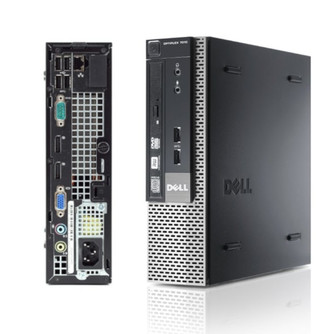Dell OptiPlex 5070 SFF vs. Dell OptiPlex 7010 USFF
Comparison and Differences
Differences between Dell OptiPlex 5070 SFF and Dell OptiPlex 7010 USFF
If you are looking for a more modern desktop, then you should go with the Dell OptiPlex 5070 SFF which was released in 2019. The Dell OptiPlex 7010 USFF is older and entered production in 2012.
If you are looking for the smaller form factor the Dell OptiPlex 7010 USFF is the right one for you. It is smaller than the Dell OptiPlex 5070 SFF and will fit more easily under your desk.
Processor
Usually the newer the generation of the CPU, the better the performance and efficiency is. If your budget allows it, you should go with the Dell OptiPlex 5070 SFF as it is running a newer generation CPU. This is not to say that Dell OptiPlex 7010 USFF is bad - it can still run some powerful CPUs, albeit being an older generation.
Memory
The Dell OptiPlex 5070 SFF has 4 RAM slots while the Dell OptiPlex 7010 USFF has only 2 slot(s). This is not something to worry about. Just make sure you take it into consideration when planning how much RAM you are going to use.
The Dell OptiPlex 5070 SFF is using the faster 2666 MT/s RAM. The Dell OptiPlex 7010 USFF is slower by supporting RAM speeds of up to 1600 MT/s. Additionally, if you will be needing a lot of RAM, better go for the Dell OptiPlex 5070 SFF as it has the ability to run 64 GB of RAM. The Dell OptiPlex 7010 USFF can do a bit less at max 16 GB. Most of the times, this should be sufficient for the majority of users.
Ports
In total the Dell OptiPlex 5070 SFF has 10 USB ports. The Dell OptiPlex 7010 USFF is inferior in this regard and packs 6 USB ports. In any case, if you miss USB ports, you can always purchase a USB hub. What is nice about the Dell OptiPlex 5070 SFF, is that it has 1 USB 3.1 port(s) which allows transfer of up to 10Gb/s. Unfortunately, the Dell OptiPlex 7010 USFF has no such port, thus restricting your transfer speeds significantly. For people who want to use external drives on regular basis, this might be an issue.
The DisplayPort is usually the more popular video port used with desktops and laptops, while the HDMI is used predominantly in consumer electronics. That's why, it is good to see that both of the models come with a DisplayPort.
None of the models has an HDMI port. If your monitor supports only the HDMI interface, you will need to buy an adapter. Such adapters are cheap so nothing to worry about.
SATA ports are placed on the system board and it is where you connect your HDD, SSD and Optical Disk Drives. More SATA slots will allow you to have more drives running at the same time. In this regard the Dell OptiPlex 5070 SFF is better equipped as it comes with 3 SATA slot(s), while the Dell OptiPlex 7010 USFF has 2 slot(s).
If you want the fastest transfer speeds for your SSD, an M.2 interface is crucial. Thus, if the M.2 SSD slot is a mandatory requirement for you, go with the Dell OptiPlex 5070 SFF. Sadly, the Dell OptiPlex 7010 USFF has no such slot, and you will be forced to use the SATA interface instead.
Make sure that the available M.2 slot supports the PCIe (also called NVMe) interface. This is important as there are M.2 slots which support only the inferior SATA III interface. For comparison, the SATA III interface has max speeds of 6Gb/s, while the PCIe 3.0 x4 will support speeds up to 32Gb/s!
Power Supply
Looking at the Power Supply Unit (PSU) of the two models we don't see any differences. For either of them you get a maximum power of 200 Watts. However be careful, many models have more than one power supply option. When buying your computer, it is a good idea to get a version with the most powerful PSU. This will potentially allow you to upgrade to a more powerful GPU for example.





